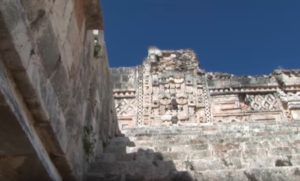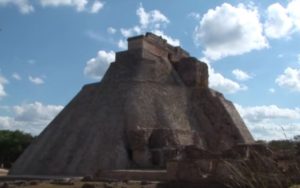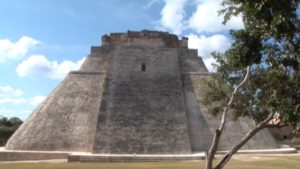Podcast: Play in new window | Download
Subscribe: Apple Podcasts | RSS
 The year was 1841. Thirty-five-year-old John Lloyd Stephens suddenly had a lot of time on his hands. US President Martin van Buren had appointed Stephens Special Ambassador to the Federal Republic of Central America, a young and struggling country that fell apart while he was stationed there. Stephens, a man who had already explored many parts of the world, decided to take a look around Central America and southern Mexico. He was joined by his friend and former traveling companion, the English artist and architect Frederick Catherwood, who would document their discoveries with intricate illustrations and diagrams. Stephens, chronicled their adventures in two books. In his books, he dazzled the English-speaking world with his descriptions of the fascinating, jungle-encrusted lost city that the locals called Uxmal. Scholars debate the origin of the word, but many believe the name comes from the Maya word, uchmal, which loosely means, “That which is to come.” Others believe that it comes from another Maya word oxmal meaning “three times built.” Stephens documents his second visit to Uxmal with Catherwood in his 1843 book, Incidents of Travel in Yucatan. The book captivated American audiences. Here is how Stephens describes his return on horseback to the ruined city:
The year was 1841. Thirty-five-year-old John Lloyd Stephens suddenly had a lot of time on his hands. US President Martin van Buren had appointed Stephens Special Ambassador to the Federal Republic of Central America, a young and struggling country that fell apart while he was stationed there. Stephens, a man who had already explored many parts of the world, decided to take a look around Central America and southern Mexico. He was joined by his friend and former traveling companion, the English artist and architect Frederick Catherwood, who would document their discoveries with intricate illustrations and diagrams. Stephens, chronicled their adventures in two books. In his books, he dazzled the English-speaking world with his descriptions of the fascinating, jungle-encrusted lost city that the locals called Uxmal. Scholars debate the origin of the word, but many believe the name comes from the Maya word, uchmal, which loosely means, “That which is to come.” Others believe that it comes from another Maya word oxmal meaning “three times built.” Stephens documents his second visit to Uxmal with Catherwood in his 1843 book, Incidents of Travel in Yucatan. The book captivated American audiences. Here is how Stephens describes his return on horseback to the ruined city:
“In ten minutes, emerging from the woods, came out upon the open field in which, grand and lofty as when we saw it before, stood the House of the Dwarf; but the first glance showed us that year had made great changes. The sides of the lofty structure, then bare and naked, were now covered with high grass, bushes, and weeds, and on the top were bushes and trees twenty feet high. The House of the Nuns was almost smothered, and the whole field was covered with a rank growth of grass and weeds, over which we could barely look as we rode through. The foundations, terraces, and tops of the buildings were overgrown, weeds and vines were rioting and creeping on façades, and mounds, terraces, and ruins were a mass of destroying verdure. A strong and vigorous nature was struggling for mastery over art, wrapping the city in its suffocating embraces, and burying it from sight. It seemed as if the grave was closing over a friend, and we had arrived barely in time to take our farewell.”
Since the days of Stephens and Catherwood, the main buildings of Uxmal have been cleaned up and restored by the Mexican government, almost to their original splendor. The site has a mysterious history and some of the most unique architecture in the ancient Maya world. In 1996, the United Nations Educational, Scientific and Cultural Organization – UNESCO – declared Uxmal a World Heritage Site. The city thus joined other famous pre-Hispanic Mexican cities: Chichén Itzá, Teotihuacán, El Tajin, Monte Albán and Palenque.
 When the Spanish arrived in the western Yucatán Peninsula in the 1540s, they easily stumbled upon the ruins of Uxmal because the city lies between two major colonial Spanish towns, Mérida and Campeche, in what is called the Puuc Hills. In the 1550s there were still people living there, among the crumbling buildings, although the city’s most important time was five centuries before. Archaeologists are not sure when people started living at the site, although most researchers generally agree that Uxmal’s rise to prominence began around 850 AD. There are two local stories about the development of the city. One claims that Uxmal was founded around 500 AD by a man with five names: Hun Uitzil Chac Tutul Xiu. The other story involving the origins of the city’s rise to prominence and its monumental architecture is more fanciful and magical. According to legend, it involves a witch, an egg, a disgruntled king and a dwarf with special powers.
When the Spanish arrived in the western Yucatán Peninsula in the 1540s, they easily stumbled upon the ruins of Uxmal because the city lies between two major colonial Spanish towns, Mérida and Campeche, in what is called the Puuc Hills. In the 1550s there were still people living there, among the crumbling buildings, although the city’s most important time was five centuries before. Archaeologists are not sure when people started living at the site, although most researchers generally agree that Uxmal’s rise to prominence began around 850 AD. There are two local stories about the development of the city. One claims that Uxmal was founded around 500 AD by a man with five names: Hun Uitzil Chac Tutul Xiu. The other story involving the origins of the city’s rise to prominence and its monumental architecture is more fanciful and magical. According to legend, it involves a witch, an egg, a disgruntled king and a dwarf with special powers.
Long ago, an old woman lived on the outskirts of the town of Uxmal which was not big or influential in the region at the time. In fact, it was ruled by a petty king and there were no larger stone buildings in the settlement when the old woman lived there. The townsfolk knew the old woman was a witch and they kept their distance from her because they feared her magical abilities. What the people of the town of Uxmal did not know is that the old witch was very lonely and was sad that she did not have children. One day she found a strange egg in the forest and brought it back to her small house. She put the egg in the corner and waited for it to hatch, wondering what would emerge from the egg. After a few days, a baby appeared, and the old witch was delighted because she would finally have the opportunity to raise a child. The baby was curious, smart and precocious and matured quickly, but he never grew in size. He was ultimately a dwarf. The witch had great plans for her son and thought that one day he would rule over the little town. She prompted him to challenge Uxmal’s king for control of the city. The king was amused by the dwarf and decided to take him up on his little game. The first part of the challenge was to see who could build a straight road between the towns of Uxmal and  Kabah. With his magical powers, the dwarf made a beautiful road out of glistening white limestone over the course of the day. The petty king was furious and issued another challenge to the uppity little man. The ruler told the dwarf to build the tallest building in the town and if he didn’t he would be killed. Overnight, he met the ruler’s challenge and built the unique pyramid of Uxmal, known today as the House of the Dwarf or the Pyramid of the Magician. The king was even angrier and issued a final challenge. They would gather up a hard fruit grown in the area called cocoyote and would hit each other over the head with the fruits. Before the challenge, the dwarf returned home and his mother the witch rubbed a magical corn tortilla on his forehead. So, when the king hit the dwarf in the head with the hard cocoyote fruit, nothing happened to him. On the third try of the dwarf hitting the king on the head, though, the king was fatally wounded and died. The magical dwarf was made king of Uxmal and built up the backwater town into an impressive city of stone.
Kabah. With his magical powers, the dwarf made a beautiful road out of glistening white limestone over the course of the day. The petty king was furious and issued another challenge to the uppity little man. The ruler told the dwarf to build the tallest building in the town and if he didn’t he would be killed. Overnight, he met the ruler’s challenge and built the unique pyramid of Uxmal, known today as the House of the Dwarf or the Pyramid of the Magician. The king was even angrier and issued a final challenge. They would gather up a hard fruit grown in the area called cocoyote and would hit each other over the head with the fruits. Before the challenge, the dwarf returned home and his mother the witch rubbed a magical corn tortilla on his forehead. So, when the king hit the dwarf in the head with the hard cocoyote fruit, nothing happened to him. On the third try of the dwarf hitting the king on the head, though, the king was fatally wounded and died. The magical dwarf was made king of Uxmal and built up the backwater town into an impressive city of stone.
The architecture at Uxmal is impressive and probably not because of the influence of a magical dwarf. Most of the larger buildings at the site were built sometime between the years 850 and 900 AD, although archaeologists are not exactly sure. The building tradition found at Uxmal is known as the Puuc style and is named for the surrounding hills and region. According to Wikipedia, the Puuc style is exemplified by:
“Buildings decorated with carefully cut veneer stones set into a concrete core. The lower portion of the façades are blank with a flat surface of rectangular blocks punctuated by doorways, while the upper façade is richly decorated with intricate stone mosaics, often alternating repeated geometric elements with more elaborate figurative sculpture. Long-nosed masks (commonly believed to be of the Maya rain god Chaac) are found on many Puuc buildings.”
The tallest structure in Uxmal is undoubtedly the large stepped pyramid named after the magical dwarf. In Spanish it is referred to as El Adivino. It is unusual in the Maya world in that it has a curved or rounded appearance instead of being straight and angular. The temple at the top of the pyramid makes the structure almost 100 feet tall. The House of the Dwarf was built during 5 separate construction periods. Unlike many other pyramids throughout Mesoamerica, this one has some of its previous layers visible. Construction probably began on this structure around 800 AD. This building was originally painted red and had black, blue and yellow accents. At the top of the pyramid around the frieze of the temple there are 12 elaborately carved masks. Archaeologists originally thought that these masks represented the Maya rain god Chaac, but recent scholarship suggests they are symbolic of 12 sacred mountains located nearby.
 West of the House of the Dwarf is another of this city’s impressive structures: Casa de las Monjas or the Nunnery Quadrangle. The building complex was named by Diego Lopez de Cogulludo, a Spanish Franciscan friar who explored the ruins in the 1600s and wrote a book called Historia de Yucatán, or in English, History of Yucatán. Lopez and other early Spanish explorers thought the building complex looked like a convent, with its 74 small rooms and central common area. Archaeologists do not know what function the Casa de las Monjas served but theorize that it may have been a palace and administrative complex where rulers lived and where government officials carried out their various functions. The complex was built in various stages. Researchers found a partial calendar date on one of the buildings indicating that the last edifice was constructed in the year 906 AD. Each of the 4 buildings in the quadrangle has a unique look and was built on a different level. The carved stone designs on the Nunnery are some of the most detailed and beautiful in the entire Maya world. The western building of this complex has the most intricately decorated façade, featuring intertwined stone snakes and numerous masks featuring the hook-nosed Chaac, god of rain.
West of the House of the Dwarf is another of this city’s impressive structures: Casa de las Monjas or the Nunnery Quadrangle. The building complex was named by Diego Lopez de Cogulludo, a Spanish Franciscan friar who explored the ruins in the 1600s and wrote a book called Historia de Yucatán, or in English, History of Yucatán. Lopez and other early Spanish explorers thought the building complex looked like a convent, with its 74 small rooms and central common area. Archaeologists do not know what function the Casa de las Monjas served but theorize that it may have been a palace and administrative complex where rulers lived and where government officials carried out their various functions. The complex was built in various stages. Researchers found a partial calendar date on one of the buildings indicating that the last edifice was constructed in the year 906 AD. Each of the 4 buildings in the quadrangle has a unique look and was built on a different level. The carved stone designs on the Nunnery are some of the most detailed and beautiful in the entire Maya world. The western building of this complex has the most intricately decorated façade, featuring intertwined stone snakes and numerous masks featuring the hook-nosed Chaac, god of rain.
South of the Pyramid of the Magician exists a long and low-lying building sitting atop a platform called The Governor’s Palace. It has the longest decorated façades in all of ancient Mesoamerica. The decoration of these façades features some 400 glyphs of the planet Venus among the 103 carved masks of Chaac alongside elaborate lattice patterns, cloud figures and human images. Eight two-headed stone serpents slither above the main doorway to this palace. Archaeologists also debate the purpose of this building. With its many Venus glyphs and its curious alignment, it may have had some astrological significance. Others think that in this case the name suits the building and that the Governor’s Palace may have had offices having to do with collecting taxes or serving some other administrative functions.
There are many other interesting buildings at Uxmal while not being so impressive in scale, they do exude their own unique charm. One such building is called La Casa de las Tortugas, or The House of the Turtles. It is a rather small building compared to those previously mentioned, but the ancient Maya decorated the building’s façade with beautiful lifelike carvings of turtles that seem as if they are crawling across the structure. Uxmal also has a ball court which is presently in pretty poor condition. The original rings on the side of the court have been replaced with replicas. The Mexican National Institute of Anthropology and History was afraid of further exposure to the elements. For more information about the ancient Mexican ball game, please see Mexico Unexplained episode number 53: https://mexicounexplained.com//the-mesoamerican-ballgame/
While much of the grand architecture of this site has been preserved, very little is known about Uxmal’s complex history. Most of the hieroglyphic inscriptions at the site exist among the various stelae, the large stone monoliths found throughout the ancient Maya world that depict the noble deeds and lineages of kings and queens. Some of the stelae at Uxmal were intentionally toppled and defaced, indicating either warfare or civil unrest. The city fell from glory at about 1000 AD when most of the classical Maya world was collapsing. While locals still inhabited the site off and on for hundreds of years later, Uxmal never returned to its former splendor. The “Lost City of the Dwarf” still keeps many secrets and the full story of Uxmal continues to be told.
REFERENCES:
Hunter, C. Bruce. A Guide to Ancient Maya Ruins. Norman, OK: University of Oklahoma Press, 1974. We are an Amazon affiliate. Buy the book on Amazon here: https://amzn.to/3dDdEUF
Kelly, Joyce. An Archaeological Guide to Mexico’s Yucatan Peninsula. Norman, OK: University of Oklahoma Press, 1993. We are an Amazon affiliate. Buy the book on Amazon here: https://amzn.to/2UO55xF
Stephen, John L. Incidents of Travel in Yucatan. New York: Dover Publications, 1963. We are an Amazon affiliate. Buy the book on Amazon here: https://amzn.to/3aoWKqW
Thompson, J. Eric S. The Rise and Fall of Maya Civilization. Norman, OK: University of Oklahoma Press, 1954. We are an Amazon affiliate. Buy the book on Amazon here: https://amzn.to/39rhUDx
Wikipedia
